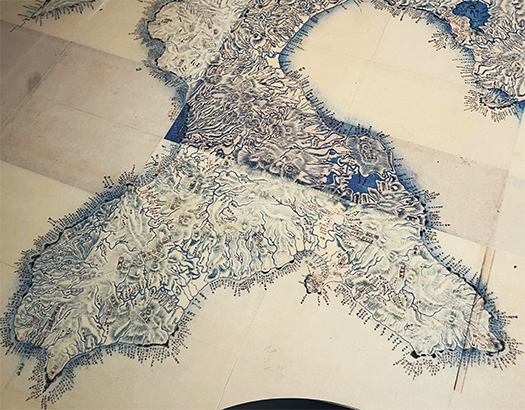

さてアイヌの人びとが明確な戦闘目標対象として「道南十二館」の志苔館攻撃に立ち上がったのが、コシャマインの戦い。松前藩の史書「新羅之記録」の記述では、総数1万にも上る攻撃軍が300の守備兵の志苔館を襲ったと書かれる。動員された人数など必ずしも信憑性は不明だけれど、道南十二館の日本武家軍団はこの戦役を経て、最終的に武田信廣という武将の統率、その軍略でアイヌ勢力を撃退した。
わたし的にはこの戦いは、農耕経済を支配しその民を軍民として統御するさまざまな戦略戦術を磨き上げていった日本の「農耕文化の戦争技術」に対し、基本的には狩猟採集による生産物を「交易」というカタチで経済構造を形成していたアイヌの民の軍事思想が蜂起し、そして無惨に散った戦いと思える。
この戦役についての資料は、「新羅之記録」のみとされ、その記録を参照しながら書かれたWEB上の記事「古城の歴史」の志苔館の条に大要が描かれている。
〜もともと狩猟民族であるアイヌ軍は、毒を塗った附子矢(ぶしや)や短弓で武装していた。館主の小林良景は300の兵で防戦するが、圧倒的な兵力差により志苔館は攻め落とされた。〜
そして12の館の内10までが陥落した段階で館主たちの協議の結果、花沢館の客将である武田信廣に戦いの総指揮を委ねることになったという。戦争を経て、軍勢の彼我の圧倒的格差に対し、軍事戦略、計略といった戦争技術を持ってアイヌ軍と戦うことに決したと想像できる。このことは戦ってみてアイヌ軍の様子も大いに「学んだ」上での結論だったのだとも思う。
そしてさまざまな計略の結果、コシャマイン本人を殺害させることに成功して、総大将を失ったアイヌ軍は戦場を放棄して一斉に撤退した。<詳細は上述のページを参照ください。>
このあたりの武田信廣の軍略ぶりについてはまるで戦国後期の桶狭間合戦(1560年)の戦い方とも通じるのではないかという感想を持った。この合戦は1457年なので、ちょうど桶狭間の100年前くらいに相当するけれど、たぶん命のやり取り、家の存続という大事が掛かった軍事戦略研究は戦国期の武将達にとっては、もっとも枢要な知的欲求対象領域だろうから、さまざまに情報流通していた可能性は高いと思う。
武田信玄が異常に怖れられたのは、なによりもその軍略が卓越していたからだろう。周辺の武将達は「対応戦略を考える」ために最新の「信玄の戦い方・戦法」を研究探索していただろう。
話が飛躍したけれど、日本社会はこういう戦国に突入していたので、要としての軍事戦略は飛躍的に発展していったことは間違いない。
一方でアイヌ社会は日常的な生活レベルで相互の「指揮命令」系統は希薄だったのではないか。
日本の農耕民たちはムラという生産単位における労働レベルで、常に集団的統御に慣れるように出来ている。労働技術に於いてもすぐに革新が導入され全体としての生産性向上が図られやすい。
狩猟採集技術探求もあっただろうけれど、さて「集団労働」という意味では疑問の余地がある。
アイヌ社会では「権力構造」というものも明確なものとは言えないのではないだろうか。
和人社会への憎悪などは共有できるだろうけれど、交易というものは基本的には「自分だけ良ければ」という思考回路に陥りやすいのではないだろうか?
北海道の歴史を考えて行く上で、この「農耕文化VS狩猟採集・交易文化」という非対称的関係は、相当大きなウェートを占めるのではないか。そんなことを考えています。みなさんいかがでしょうか?
English version⬇
The Battle of Koshamain-3: Traders, Farmers, and Warriors
In mass battles, the differences in lifestyle and culture are clearly visible in the “fighting style. The Ainu retreated from the battle due to military tactics that exceeded the size of their forces. …
The Battle of Koshamain was when the Ainu people launched an attack on Shikokan, one of the “Twelve Buildings of the Southern Domain,” as a clear target of battle. According to the Matsumae Clan’s history book, “Shilla no Kiroku,” a total of 10,000 attackers attacked Shikokan, which had 300 defenders. Although the number of troops mobilized is not entirely reliable, the Japanese warrior army of the Twelve Cantons of Southern Hokkaido ultimately defeated the Ainu forces under the leadership of a general named Takeda Nobuhiro and his military strategy.
Posted on 5月 8th, 2024 by 三木 奎吾
In my opinion, this battle was an uprising of the Ainu people’s military ideology, who basically formed their economic structure by “trading” the products of hunting and gathering, against the Japanese “agrarian culture’s war technology” that controlled the agricultural economy and refined various strategic tactics to control their people as a military people, and then they were scattered miserably. This battle seems to be a battle in which the Ainu people’s military ideology rose up and scattered miserably.
The only source for this battle is the “Records of Shilla,” and the article “History of the Old Castle” on the web, which was written with reference to the records, outlines the battle of Shikokan.
〜The Ainu, who were originally a hunting tribe, were armed with poisoned bows and arrows. The owner of the house, Yoshikage Kobayashi, defended against them with 300 men, but the overwhelming difference in force caused Shikokukan to be overrun. ~.
After 10 of the 12 pavilions had fallen, the pavilion owners discussed the matter and decided to give the general command of the battle to Nobuhiro Takeda, the guest general of Hanazawa pavilion. After the war, it can be imagined that they decided to fight the Ainu army with war techniques such as military strategy and strategy against the overwhelming gap between their forces and those of the Ainu. I believe that he concluded this after “learning” a great deal about the state of the Ainu army through the war.
As a result of the various schemes, they succeeded in having Koshamain himself killed, and the Ainu army, having lost its commander-in-chief, abandoned the battlefield and retreated en masse.
Filed under: 歴史探訪







コメントを投稿
「※誹謗中傷や、悪意のある書き込み、営利目的などのコメントを防ぐために、投稿された全てのコメントは一時的に保留されますのでご了承ください。」
You must be logged in to post a comment.